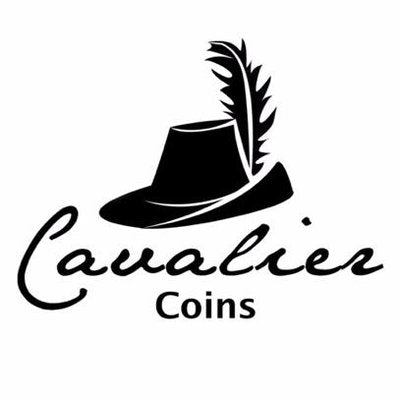More than just little bits of gold, Queen Victoria sovereigns are history you can hold in your hand. They tell the story of the British Empire at its peak, making them a fascinating target for collectors and investors who appreciate both their gold content and their rich past.
The Legacy of the Victorian Gold Sovereign
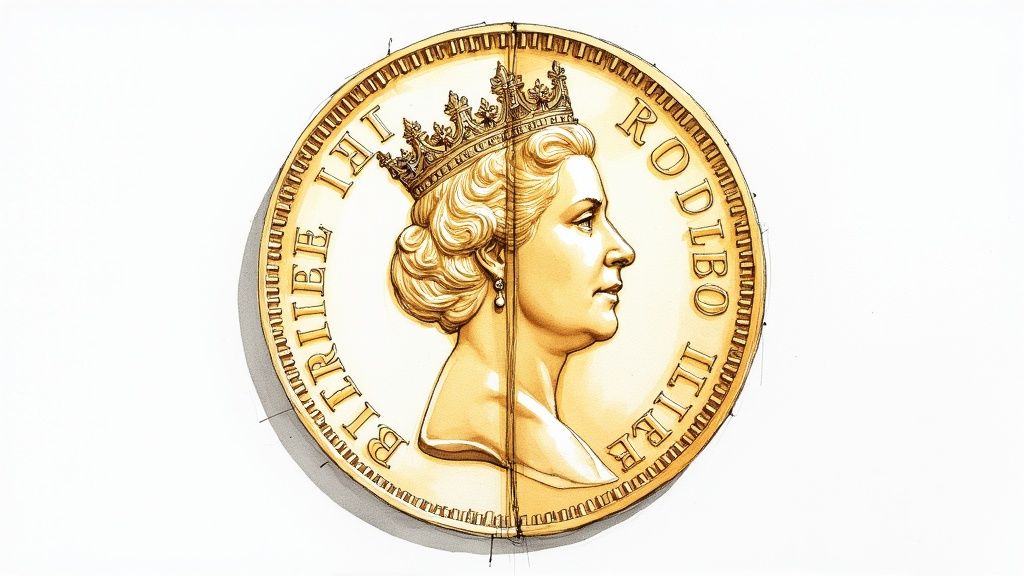
Let's step back in time. We're in an age of incredible industrial growth, worldwide trade, and the sheer scale of the British Empire. At the very centre of this economic giant was one, single, trusted coin: the Queen Victoria gold sovereign. These weren't just coins for popping to the shops; they were the foundation of Britain's financial clout and a symbol of power recognised all over the globe.
You’ve heard the saying "the sun never sets on the British Empire," and back then, it was literally true. The gold sovereign was the currency that kept this vast machine running. From the bustling London docks to remote colonial outposts in Australia and India, the sovereign was the accepted standard of value, smoothing the way for trade and stamping imperial authority on every transaction.
A Coin Forged in History
The modern sovereign as we know it actually got its start just before Victoria took the throne, after the Great Recoinage of 1816. This was a huge deal, designed to steady the nation's currency by creating a single, reliable gold standard.
Under Queen Victoria, these coins were made to a very strict recipe: 22 carat gold, weighing a precise 7.98 grams, with a pure gold content of 7.32 grams. This wasn't just a suggestion; it was a guarantee.
This unwavering consistency was the key to its success. It meant a sovereign minted in London was worth exactly the same as one struck thousands of miles away in Sydney or Melbourne. This reliability is what turned it from a simple domestic coin into the world's most important trade coin of the 19th century.
For a collector today, every Queen Victoria sovereign is like a miniature time capsule. It carries the story of where it was made, the hands it passed through, and how it survived to the present day. It's a direct, physical link to the triumphs and complexities of the Victorian age.
From Circulation to Collection
As the world eventually moved on from the gold standard, the sovereign’s job changed. It went from being a workhorse of everyday commerce to a sought-after collectible and a smart way to invest in gold. The incredible history, combined with the real value of its gold, gives it a special appeal that very few other assets can match.
Getting to grips with the wider story of British money can really help you appreciate just how special the sovereign is. To go a bit deeper, you might find our guide on a brief history of British coins an interesting read. Every sovereign you see is a small chapter in this bigger story, chronicling a 63-year reign that completely reshaped the world. This overview sets the stage perfectly for us to explore the specific designs, mint marks, and tiny details that make these coins such a captivating field for any enthusiast.
A Reign Told Through Three Portraits
Queen Victoria's incredible 63-year reign was a time of massive change for Britain, and her gold sovereigns are a perfect reflection of that story. Instead of a single, unchanging design, the coins give us a visual timeline through three distinct portraits. Each one captures a different phase of her life and monarchy.
Think of them less as simple design updates and more like chapters in a story told in gold. Each effigy, from the hopeful young monarch to the powerful Empress, connects us directly to the artistic and political climate of the 19th century.
Despite the changing portraits, the core specifications of the sovereign never wavered. This consistency was the bedrock of its reputation as a reliable global currency.
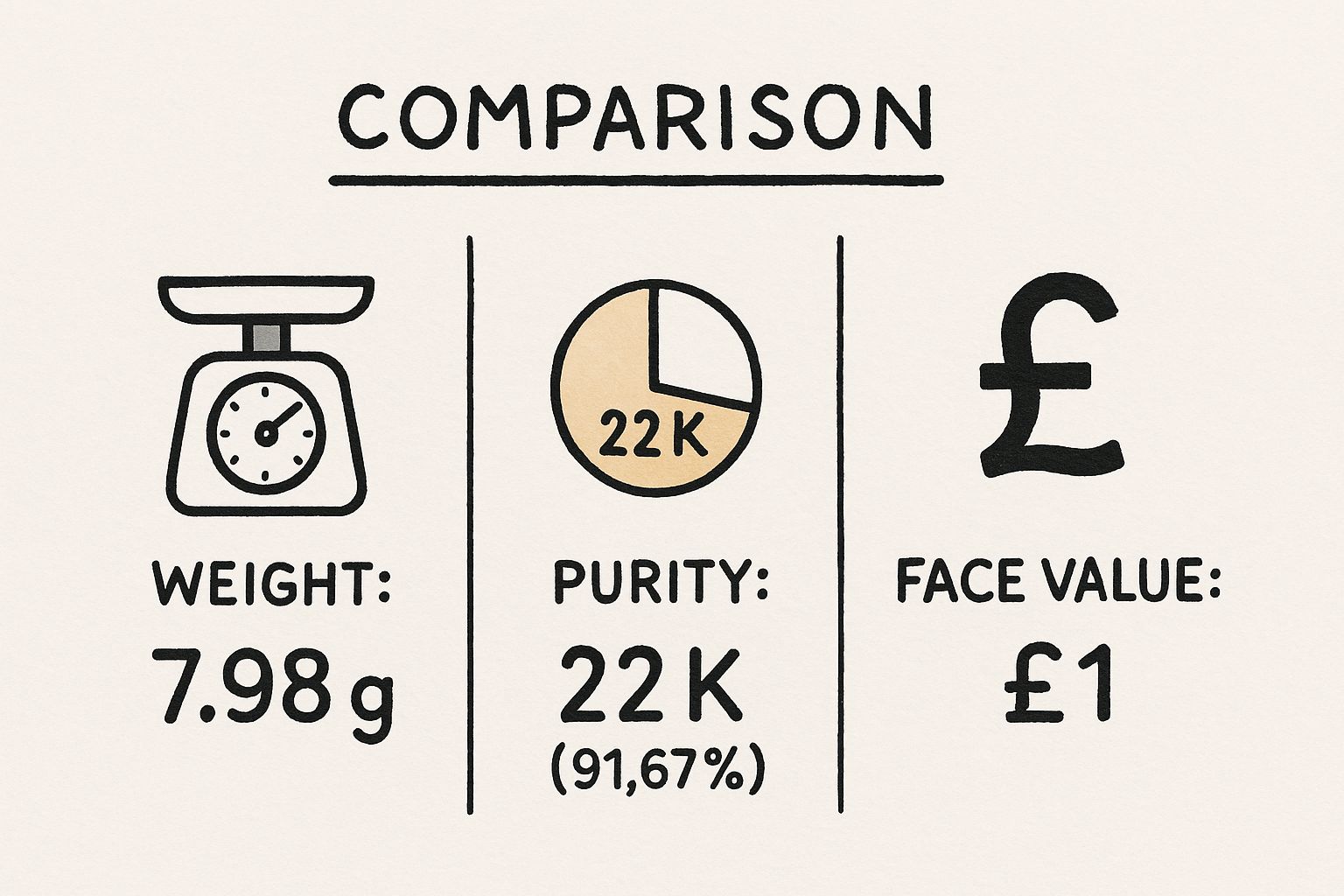
This constant weight, purity, and face value guaranteed the coin's intrinsic worth across the globe, no matter which version of the Queen it carried.
To get a quick overview of these fascinating designs, the table below breaks down the key features of each portrait. It's a handy guide for quickly identifying which era a sovereign comes from.
Identifying Queen Victoria's Portraits on Gold Sovereigns
| Portrait Type | Years of Issue | Key Identifying Feature | Primary Reverse Design |
|---|---|---|---|
| Young Head | 1838–1887 | Youthful portrait with hair tied in a "Grecian knot". | Shield Back (early) or St George & Dragon (later) |
| Jubilee Head | 1887–1893 | Mature portrait wearing a small crown over a widow's veil. | St George & Dragon |
| Old Head | 1893–1901 | Elderly, veiled portrait showing a dignified, aged monarch. | St George & Dragon |
As you can see, a quick look at the Queen's hairstyle and headwear is often all you need to place the coin in its correct historical period. Now, let's explore each of these iconic portraits in more detail.
The Hopeful Young Head Portrait
First up is the 'Young Head', which graced sovereigns from 1838 to 1887. As the longest-running design, it's often the image people first associate with a young Victoria. The portrait shows her with her hair elegantly pulled back into a bun, a style known as a "Grecian knot".
Crafted by the celebrated Royal Mint engraver William Wyon, this effigy beautifully captures the grace and optimism of a new monarch taking the throne. The Young Head series also has its own sub-variations, especially on the reverse. Early coins feature a shield back design, which was later replaced by the iconic St George and the Dragon we know so well today.
The Imperial Jubilee Head Portrait
In 1887, to celebrate Queen Victoria’s Golden Jubilee, a brand new portrait was introduced. The 'Jubilee Head' sovereign, minted for just six years from 1887 to 1893, presents a completely different image. Designed by Sir Joseph Edgar Boehm, it shows a more mature Queen wearing a tiny, almost delicate crown on top of her widow's veil.
The design was meant to project the power and grandeur of the Empress of India, marking the peak of British imperial might. It didn't quite land, however. The portrait proved controversial, with critics at the time feeling the small crown looked awkward and almost comical. It ended up being one of the shortest-lived portraits in British coinage history.
The Dignified Old Head Portrait
The final chapter is the 'Old Head', or 'Veiled Head', which circulated from 1893 until Victoria's death in 1901. This design, by Sir Thomas Brock, is widely considered the most poignant and successful of the three. It depicts a dignified, elderly monarch, her face showing the wisdom of her years, wearing a coronet and a long veil draping over her shoulders.
This portrait masterfully balances the reality of her old age with the enduring majesty of her rule. It’s a powerful final statement for a monarch who oversaw an era of unprecedented global change. For many new collectors, Old Head sovereigns are a natural starting point, as they are readily available and represent the culmination of an extraordinary reign.
Decoding Mint Marks: A Global Empire in Gold
As the British Empire stretched across the globe, so did the need for its most trusted currency. A tiny letter, often no bigger than a pinhead, stamped onto a Queen Victoria gold sovereign tells a huge story of this global expansion. This is the mint mark, and for any collector, it’s a crucial detail – a postcode that reveals exactly where in the world that specific coin was struck.
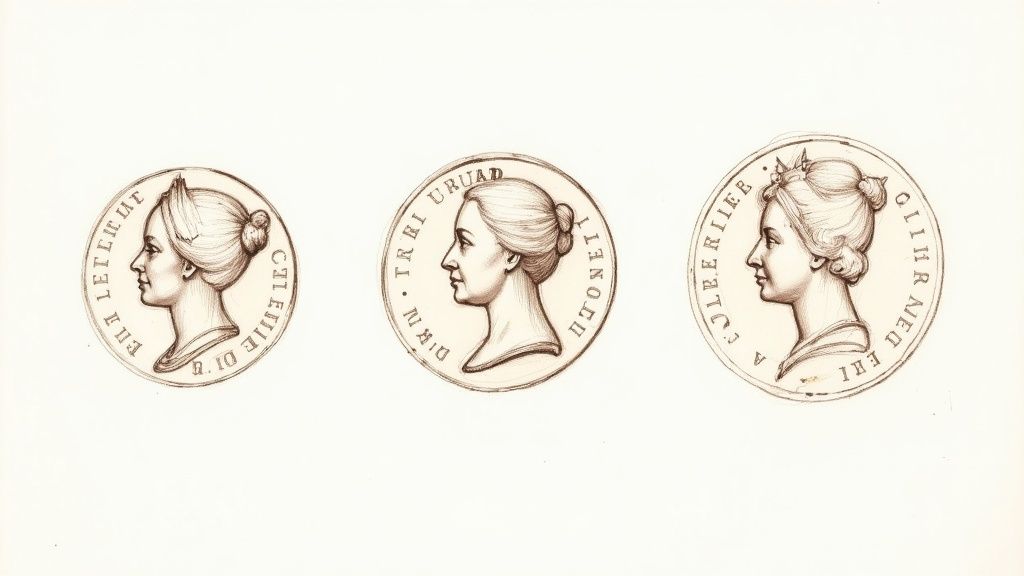
Think of it like a car's manufacturing plant. Two identical models might roll off assembly lines in different countries, and for enthusiasts, that difference really matters. In the same way, knowing a sovereign's origin is key to understanding its history and, very often, its rarity. During Victoria's reign, sovereigns weren't just made in London; they were also struck at branch mints across the Empire.
These overseas mints were set up for a very practical reason: gold rushes. When huge quantities of gold were discovered in places like Australia, it was far more efficient to turn that raw metal into sovereigns on the spot rather than ship it all the way back to Britain. This created a network of mints, each with its own unique identifier.
Identifying the Branch Mints
Finding the mint mark is your first step to becoming a more discerning collector. On most Victorian sovereigns, you’ll find it on the reverse side of the coin. Look closely in the small space just below the main design of St George and the Dragon.
The main branch mints operating during this period were all in Australia, a direct result of the continent's colossal gold discoveries. Each used a single letter to identify its coins:
- S for the Sydney Mint (opened 1855)
- M for the Melbourne Mint (opened 1872)
- P for the Perth Mint (opened 1899, right at the end of Victoria's reign)
So, what about coins from London? This is a common point of confusion for new collectors. The Royal Mint in London was seen as the primary, or "parent," mint. As such, its coins didn't need a special identifier.
Key Takeaway: If your Queen Victoria gold sovereign has no mint mark, it was struck at the main Royal Mint in London. The presence of a small S, M, or P means it came from one of the Australian branch mints.
Why Mint Marks Dictate Rarity and Value
The distinction between mints is much more than a geographical curiosity; it has a direct and often significant impact on a coin's value. This all comes down to the number of coins produced – known as the mintage – which varied wildly from one location to another and from year to year.
The London mint was a production powerhouse, frequently striking millions of sovereigns annually to meet the demands of a global empire. By contrast, the branch mints in Australia typically had much smaller production runs, as their main job was to serve local and regional economies.
This creates some fascinating scenarios for collectors. A sovereign from a particular year might be quite common if it was minted in London. But a sovereign of the exact same year with an 'S' or 'M' mint mark could be exceptionally rare and valuable, all because of a tiny mintage from that Australian branch.
This table gives a quick idea of what to expect:
| Mint Location | Typical Mintage Level | Rarity Potential |
|---|---|---|
| London (No Mark) | Very High | Generally common, with a few rare exceptions. |
| Sydney (S) | Moderate to Low | Many date/mark combinations are scarce. |
| Melbourne (M) | Moderate to Low | Certain years are highly sought after by collectors. |
| Perth (P) | Very Low (Victorian era) | Only operated for two years of her reign (1899, 1900), making these dates rare. |
Essentially, the mint mark adds another layer to the coin's identity. You aren't just looking for a specific year; you're hunting for a specific year and mint mark combination. This is where the real chase begins for collectors of Queen Victoria gold sovereigns, as finding a low-mintage coin from a branch mint can turn an everyday find into a prized possession.
How to Verify a Genuine Victorian Sovereign
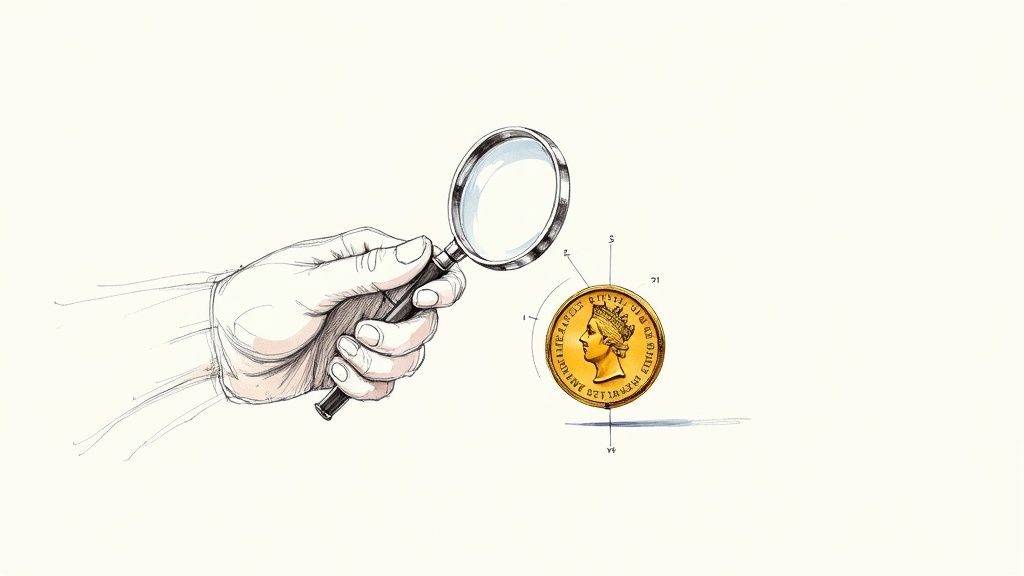
In the world of collectible coins, knowing what's real and what isn't is everything. For anyone looking at Queen Victoria gold sovereigns, developing a keen eye for genuine pieces is the most important skill you can learn. It’s what separates a casual buyer from a confident collector who can spot a true historical artefact from a clever fake.
The good news is you don't need a high-tech lab to do your initial checks. A few simple, effective methods can quickly tell you whether a coin is worth a closer look. These checks focus on the very things forgers find hardest to get right: the coin’s physical specifications and the sharpness of its design.
The Foundational Checks: Weight and Dimensions
The first and most reliable tests are always physical. The Royal Mint produced sovereigns to incredibly strict standards, a precise recipe that was followed for every single coin to guarantee its value across the Empire.
A genuine Queen Victoria gold sovereign must meet these exact specifications:
- Weight: 7.98 grams. You might see a tiny variance from circulation wear, but it should be incredibly close. A coin that's significantly lighter or heavier is an immediate red flag.
- Diameter: 22.05 mm. Again, precision is key. Counterfeits often get this wrong, even by a fraction of a millimetre.
- Thickness: 1.52 mm. This one is tougher to check without callipers, but it’s another part of the coin’s official ‘fingerprint’.
These standards weren't just for show; they were legally mandated and fiercely enforced. The Coinage Act of 1870 laid down the law, and the annual Trial of the Pyx ensured the mints stuck to it. This rigorous process meant that by 1900, only about 4% of sovereigns in circulation were underweight, cementing their role as the backbone of Britain's gold standard economy.
Understanding Coin Condition and Grading
Beyond simple authenticity, a coin’s condition, or grade, is what drives its value. Grading is just a shorthand for describing how much wear a coin has picked up over the years. While official grading is a job for seasoned experts, knowing the basic terms will help you assess any potential purchase.
For Victorian sovereigns, you'll most often see these terms:
- Very Fine (VF): The coin shows clear wear, especially on its highest points. The main details are there, but some of the finer lines—like the Queen’s hair or the dragon's scales—have started to soften.
- Extremely Fine (EF): This coin has only been lightly circulated. The details are sharp and clear, with just a hint of wear on the most prominent features. It will still have a lot of its original mint lustre.
- Uncirculated (UNC): A perfect coin with no signs of wear at all. It looks just as it did the day it left the mint, with full lustre and razor-sharp details.
Learning to judge a coin's condition is a skill that comes with experience. For a deeper look at this, check out our guide on how to value coins for UK collectors.
A Collector's Tip: When you're looking at a coin, focus on the highest points of the design—the Queen's hair, the dragon's head, and the horse's shoulder. These are the first places to show wear and are great indicators of the coin's true grade.
Spotting the Red Flags of a Fake
Counterfeiters have become much more sophisticated over the years, but their fakes nearly always have giveaways. Knowing what to look for can save you from a very costly mistake.
Here are some of the most common signs of a counterfeit:
- Mushy or Soft Details: Genuine sovereigns have incredibly sharp, crisp details. Fakes often look ‘soft’ or blurry, as if the die used to strike them wasn't quite right.
- Incorrect Weight or Size: As we said, this is the biggest giveaway. If you have any doubt at all, weigh the coin.
- Wrong 'Colour' or Lustre: Real sovereigns are made from 22-carat gold, which has a distinct, rich, warm hue. Fakes made from other alloys or with gold plating can look too brassy, unnaturally shiny, or just dull.
- Edge Irregularities: The reeded (milled) edge of a sovereign should be uniform and perfectly defined. Poor copies might have uneven milling or even a visible seam where two halves were joined together.
By combining these checks—verifying the physical stats, assessing the condition, and looking for common flaws—you can build a strong defence against fakes. It's a careful approach that will give you the confidence to navigate the market and make sure every Queen Victoria sovereign you buy is a genuine piece of history.
Strategies for Collecting and Investing
Jumping into the world of Queen Victoria sovereigns can feel a bit overwhelming at first, but with a clear plan, it's an incredibly rewarding journey. Whether you're looking to build a historically rich collection or make a smart investment, a bit of strategy goes a long way.
Think of it like this: are you a historian, an investor, or a bit of both? Knowing your primary goal will shape every decision you make.
Collecting by Type
One of the most popular approaches is to collect by "type". This means acquiring one example of each major design variation. For the Victorian era, that's a beautifully manageable goal.
A classic Victorian type set would include:
- One Young Head Shield Back sovereign (1838–1874)
- One Young Head St George and the Dragon sovereign (1871–1887)
- One Jubilee Head sovereign (1887–1893)
- One Old Head sovereign (1893–1901)
This gives you a fantastic overview of the entire reign, showcasing the evolution of royal portraiture and coin design in just four coins. It’s a brilliant way to start without breaking the bank.
Collecting by Date or Mint
For those who love a challenge, collecting by date or mint is the next level up. This involves tracking down a sovereign for every year they were produced, or from each specific mint.
A date run of the Old Head series, for example, is a common and achievable goal. Things get much tougher with the Young Head series, especially with the rare Shield Backs from the early years. Some of those dates are incredibly scarce and command serious premiums.
Mint collecting adds another layer of complexity and fun. You could aim to get a sovereign from each of the branch mints—Sydney (S), Melbourne (M), and later Perth (P)—for a specific year or design type. This tells a fascinating story of the British Empire's global reach.
Investing in Key Dates and High-Grade Coins
If your focus is more on investment, your strategy shifts towards rarity and condition. Instead of trying to complete a set, you might concentrate on acquiring key date coins – the years with the lowest mintages or highest scarcity.
Condition is everything here. A common date sovereign in pristine, uncirculated condition can often be a better investment than a rare date in poor shape. The difference in value between a circulated coin and a top-grade example can be staggering. High-grade, or "Mint State," coins are always in demand from serious collectors and investors.
No matter which path you choose, remember that knowledge is your best asset. Take the time to understand grading, research market values, and always buy from reputable sources. For more general advice, have a look at our guide on seven tips for buying collectable coins.
Common Questions About Queen Victoria Sovereigns
Diving into the world of Queen Victoria sovereigns can feel a little daunting at first. It’s a field rich with history and detail, so it's only natural to have questions. This section is all about tackling those common queries we hear from both newcomers and seasoned collectors alike.
We’ll break down everything from what makes a sovereign valuable to how to spot the truly rare ones. Think of it as your practical guide to building a collection with confidence.
How Is a Queen Victoria Gold Sovereign Valued?
The price of a Queen Victoria sovereign isn't just one simple number; it's really a combination of two key things. Think of it like a vintage sports car. Part of its value is the raw metal it’s made from, but the rest comes from its history, rarity, and how much collectors want it.
First, you have its bullion value. This is the coin's baseline price, tied directly to the spot price of its 7.32 grams of pure gold. This gives the coin a solid price floor – it will never be worth less than the gold it contains.
The second, and often more exciting, factor is its numismatic value. This is the premium a collector will pay for things like a rare date, a specific mint, or its physical condition (known as its grade). This collector's premium can be anything from a few pounds for a common coin to thousands for a truly exceptional specimen.
A common, well-circulated sovereign might trade for a price that's very close to its gold value. But a rare date from an Australian branch mint in pristine, uncirculated condition could be worth many, many times its weight in gold. That’s the power of numismatics.
What Are the Rarest Queen Victoria Sovereigns?
When it comes to rarity in Victorian sovereigns, it almost always boils down to two details: the year it was made and its mint mark. A coin's scarcity is simply a reflection of how many were struck in that specific year, at that particular mint.
Sovereigns from the Australian branch mints—Sydney (S), Melbourne (M), and Perth (P)—were often produced in much smaller numbers than those from the London mint. This alone makes many of their issues much harder to find.
Here are a few famous examples of rare Queen Victoria sovereigns:
- The 1855 and 1856 Sydney Mint Sovereigns: These early coins from Australia's first mint are absolute classics and highly sought after.
- The 1841 London Mint Sovereign: An incredibly rare date from the 'Young Head' series. Very few are known to exist today.
- Certain Shield Back Varieties: Some years from the early 'Shield Back' design period are exceptionally difficult to track down.
To know if you have a rare coin, you have to check both the date on the front and the mint mark on the back (it's usually a tiny letter just below St George and the Dragon).
What Should I Look for When Buying My First Sovereign?
For your first purchase, your two biggest priorities should be authenticity and condition. The easiest way to get a genuine coin is to buy from a specialist coin dealer or a well-regarded bullion merchant. This takes a huge amount of risk out of the equation.
A brilliant place for any new collector to start is with a common-date sovereign in a high grade, like 'Very Fine' (VF) or 'Extremely Fine' (EF). This gives you a great balance of quality and cost, letting you own a beautiful piece of history without breaking the bank.
Once you have a coin in your hands, there are a few simple checks you can do:
- Make sure its weight is spot on, or very close to the standard 7.98 grams.
- Check for any obvious damage, like deep scratches or signs it was mounted in jewellery, as this will lower its value.
- Look for sharp, crisp details. A blurry or soft-looking coin is often a sign of heavy wear.
Starting with a common 'Jubilee Head' or 'Old Head' sovereign is a fantastic and rewarding way to begin your collecting journey.
Are Victorian Sovereigns a Good Investment?
Victorian sovereigns are widely seen as a solid investment, and for good reason. They have a unique double appeal, blending the security of holding a physical asset with the growth potential that comes from collector demand.
First and foremost, their gold content gives them an intrinsic value that acts as a great hedge against inflation and economic jitters. If the price of gold goes up, the base value of your sovereign goes up with it. On top of that, they have numismatic value, which can grow completely independently of the gold market, especially for rare or high-grade coins.
For UK residents, there’s another huge plus: Queen Victoria gold sovereigns are exempt from both Capital Gains Tax (CGT) and Value Added Tax (VAT). This is because they are classified as official British legal tender. This tax-free status makes them a particularly smart way to diversify an investment portfolio, offering the stability of precious metal and the unique appeal of a historic collectible.
At Cavalier Coins Ltd, we are passionate about connecting collectors with genuine pieces of history. Whether you are looking for your very first sovereign or seeking a rare date to complete your set, we invite you to explore our carefully curated selection. Discover the perfect addition to your collection by visiting us at https://www.cavaliercoins.com.
